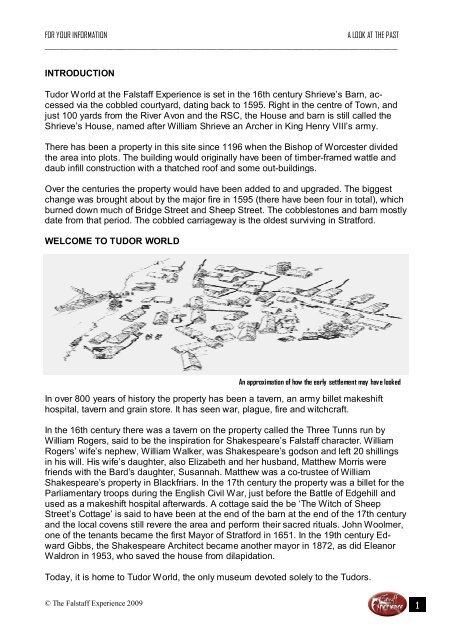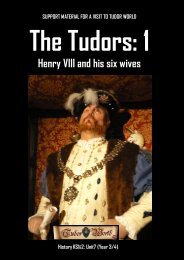Keystages 1 & 2: An interactive literacy trail - The Falstaffs Experience
Keystages 1 & 2: An interactive literacy trail - The Falstaffs Experience
Keystages 1 & 2: An interactive literacy trail - The Falstaffs Experience
You also want an ePaper? Increase the reach of your titles
YUMPU automatically turns print PDFs into web optimized ePapers that Google loves.
FOR YOUR INFORMATION A LOOK AT THE PAST<br />
_____________________________________________________________________________________________________________________<br />
INTRODUCTION<br />
Tudor World at the Falstaff <strong>Experience</strong> is set in the 16th century Shrieve’s Barn, accessed<br />
via the cobbled courtyard, dating back to 1595. Right in the centre of Town, and<br />
just 100 yards from the River Avon and the RSC, the House and barn is still called the<br />
Shrieve’s House, named after William Shrieve an Archer in King Henry VIII’s army.<br />
<strong>The</strong>re has been a property in this site since 1196 when the Bishop of Worcester divided<br />
the area into plots. <strong>The</strong> building would originally have been of timber-framed wattle and<br />
daub infill construction with a thatched roof and some out-buildings.<br />
Over the centuries the property would have been added to and upgraded. <strong>The</strong> biggest<br />
change was brought about by the major fire in 1595 (there have been four in total), which<br />
burned down much of Bridge Street and Sheep Street. <strong>The</strong> cobblestones and barn mostly<br />
date from that period. <strong>The</strong> cobbled carriageway is the oldest surviving in Stratford.<br />
WELCOME TO TUDOR WORLD<br />
In over 800 years of history the property has been a tavern, an army billet makeshift<br />
hospital, tavern and grain store. It has seen war, plague, fire and witchcraft.<br />
In the 16th century there was a tavern on the property called the Three Tunns run by<br />
William Rogers, said to be the inspiration for Shakespeare’s Falstaff character. William<br />
Rogers’ wife’s nephew, William Walker, was Shakespeare’s godson and left 20 shillings<br />
in his will. His wife’s daughter, also Elizabeth and her husband, Matthew Morris were<br />
friends with the Bard’s daughter, Susannah. Matthew was a co-trustee of William<br />
Shakespeare’s property in Blackfriars. In the 17th century the property was a billet for the<br />
Parliamentary troops during the English Civil War, just before the Battle of Edgehill and<br />
used as a makeshift hospital afterwards. A cottage said the be ‘<strong>The</strong> Witch of Sheep<br />
Street’s Cottage’ is said to have been at the end of the barn at the end of the 17th century<br />
and the local covens still revere the area and perform their sacred rituals. John Woolmer,<br />
one of the tenants became the first Mayor of Stratford in 1651. In the 19th century Edward<br />
Gibbs, the Shakespeare Architect became another mayor in 1872, as did Eleanor<br />
Waldron in 1953, who saved the house from dilapidation.<br />
Today, it is home to Tudor World, the only museum devoted solely to the Tudors.<br />
© <strong>The</strong> Falstaff <strong>Experience</strong> 2009<br />
<strong>An</strong> approximation of how the early settlement may have looked<br />
1



